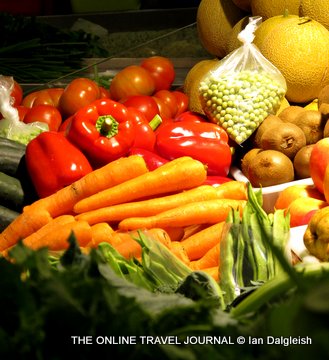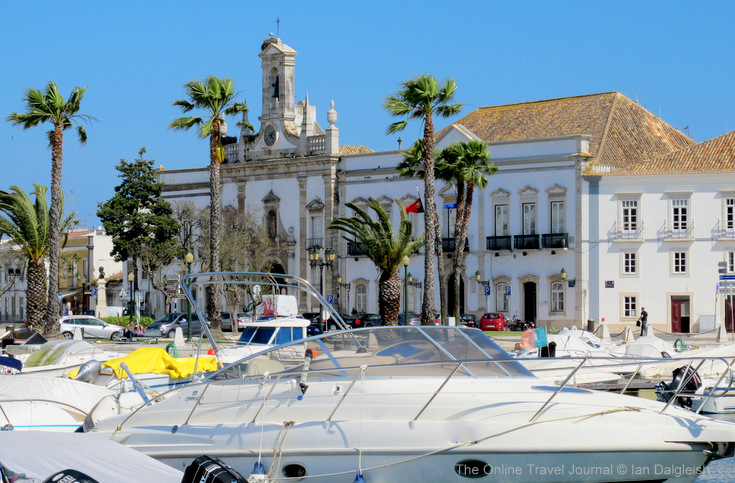A Day in Faro
We find a city of many layers with a natural park on its doorstep
“It would be better for Faro if the airport wasn’t here”, opinioned the man in the hotel.
Faro is a place many people fly to and then pass straight by, speeding off down the motorway to other Algarve destinations. We too were hiring a car from the airport and heading elsewhere, but first, our curiosity kindled by mentions of Roman and Moorish history and the nearby wildlife rich Ria Formosa lagoon, we had arranged to spend a day exploring Faro.
To save time getting around we picked a central hotel, Hotel Faro, for our stay; it couldn’t have been more conveniently situated between the marina, the old quarter and attractive shopping streets. We didn’t have an agenda as such; I’m more inclined to visit buildings and museums, Ian as a photographer likes to observe, get a sense of a place, what makes it distinctive. We walk a lot.
This is how the day unfolded …
A fine start to the day breakfasting in the terraced roof-top restaurant eye to eye with nesting storks. Big untidy nests everywhere; up against chimneys, in bell towers, on lamp posts. The views are good, hickledy pickledy roof tops in one direction, palm trees, the marina and lagoon beyond in another.
We both want to visit the market but decide to take a stroll through the old walled town first. A short walk alongside the waterfront gardens brings us to the Arco da Vila with bell tower and three nesting storks atop. The gate, built at the instigation of Bishop Dom Francisco Gomes do Avelar who did much to restore Faro after it was damaged the 1755 Lisbon earthquake, stands over an earlier Medieval castle gate – we can see some original Moorish and Roman brickwork still doing its job in the archway. Leading us on a narrow street curves up hill between whitewashed buildings, there are pavements to the side too narrow for comfortable walking but handy for hopping onto to let a car pass. At the top we come out into a open cobbled square lined with orange trees, the cathedral is ahead being used as a backdrop for a photo shoot for a child’s pedal car. It’s €3 to visit the cathedral which dates from the 13th century but the light’s still good for photos, we’ll come back later and take a look.
Leaving the old city through graffiti covered remains of old walls by the Castle we get a close up look of the lagoon. It’s low water, the channels between islands distinct, birds are feeding on mudflats, a fisherman in an open boat is harvesting shellfish – clams maybe? There’s a tidy walk way around the outside of the walls; a jogger pauses in her run and makes use of a bench to do some stretching exercises, ahead a modern catamaran tripper boat is pulling alongside a jetty. We get chatting about Faro with a chap wearing a flat cane woven cap promoting trips in a traditional, high prowed boat. The market is a good place to see the social side of the city he thinks, but the stalls will close in an hour or two, best to go now and take a boat ride later. Head inland from Hotel Faro and keep on as straight as possible, he tells us.
 The Mercado Municipal turns out to be a modern building, it looks purpose built with a large car park out front. Inside the main floor is occupied by market stalls selling fresh produce, fish, cheeses, preserved meats, grains and cereals – the ingredients I never have to hand when I’m inspired to try a recipe from my Portuguese cookbook. Above is a bank and on the lower floor a supermarket, a shoe shop and other useful outlets. It’s spotlessly clean. We gravitate, as always, to the fish marvelling at the freshness, quantity and variety: sardines, hake, dorado, Moray eels, colourful striped red mullet …… The stall holders are friendly, proud of their catch, holding up fish for Ian to photograph. “The Best Fish Of The World” is the message of the Portuguese Tourist Board, they could well be right.
The Mercado Municipal turns out to be a modern building, it looks purpose built with a large car park out front. Inside the main floor is occupied by market stalls selling fresh produce, fish, cheeses, preserved meats, grains and cereals – the ingredients I never have to hand when I’m inspired to try a recipe from my Portuguese cookbook. Above is a bank and on the lower floor a supermarket, a shoe shop and other useful outlets. It’s spotlessly clean. We gravitate, as always, to the fish marvelling at the freshness, quantity and variety: sardines, hake, dorado, Moray eels, colourful striped red mullet …… The stall holders are friendly, proud of their catch, holding up fish for Ian to photograph. “The Best Fish Of The World” is the message of the Portuguese Tourist Board, they could well be right.
It’s gone half past one when we leave the market – lunch time. We find a cafe and order a couple of super Bocks to quench our thirst (Bock is the most popular brand of larger in Portugal I’m told). Looking around the bright yellow soup of the day seems a popular choice – we try some, it’s good though we’re not sure what it is.
Back on the waterfront we peer over the harbour wall; a stiff breeze has blown up and the tide has come in leaving the lagoon an expanse of choppy water. Perhaps we’ll leave a boat trip. The Maritime Museum is nearby and entry only 1€. It turns out to be an old fashioned gem of a museum about the importance of the sea to the Algarve; there are unsubtle paintings of the fish found locally, instruments for navigation, models of boats and fishing tackle. A model showing how nets were laid to trap tuna passing on their annual migration has us puzzling, for real the set-up involved 139 anchors and over 4.5km of tackle. The process becomes clearer watching a old black and white documentary about the tuna fishery, it’s not only the final scene of encircled thrashing tunnies, fishermen amongst them gaffing and heaving the fish into the boats that makes an impression but the almost balletic coordination of the fleet to reach this point.
Late afternoon, the light is good for photos and the shops have opened again. The pedestrianised shopping area in downtown Faro is very pleasant and refreshingly un-touristy. I like the decorative mosaic pavements I’m walking on – fish, a compass rose, geometric designs – so distinctively Portuguese. Beyond the shopping streets Ian finds much to please a photographer’s eye, a domed building traditionally trimmed in bright yellow, imaginative graffiti murals.
We end the day sharing a cataplana. I’d read about the clam like cooking pots which give their name to the dishes cooked in them but had not eaten from one before. Traditionally they’re made of copper. The waiter comes bearing our fish cataplana on a thick wooden board. With a touch of theatre the lid is opened, steamy aromas, trapped during cooking arise – it’s tasty and surprisingly filling. Mopping up the last juices with a tear of bread I’m glad Faro has become more than a name on a departure board.
I think a 2 or 3 day visit to Faro would be ideal. There would be time then to take in the Cathedral and museums, enjoy the genuine low key atmosphere of the town and take a boat trip, perhaps spend a day on Ilha Deserta – 10km of white sand and a eco restaurant serving fresh fish for lunch. Faro would also make an ideal base for exploring the area. I would like to return and explore the Ria Formosa National Park – there’s a cycle path that runs along the coast and opportunities for kayaking, horse riding, birdwatching and more.For next time
A visit to the Museu Municiple in the Largo da Se to get a better understanding of how the area was shaped, the Cathedral, some local art galleries to see how local artist view their landscape, a boat trip, and more fish.
Getting there
Taxis from the airport cost in the region of 10 Euros. The bus station is near the marina and the train station some 150 metres beyond that. No 14 & 16 buses run to the airport taking around 20 minutes. We caught a no 16 bus just opposite bus station back to the airport which cost 1.90 Euros. The No 16 bus continues from the airport to the long sand spit beach at Praia Faro.
Faro links
Formosamar are an ecotourism company that offer traditional boat, catamaran and kayak trips in the Ria Formosa and a range of other activities such as walking and birdwatching. They also rent bikes, surfboards, kayaks, boats and fishing rods.
Regular runs to Ilha Deserta, boat trips and birdwatching in the Ria Formosa.
Faro city web site with practical information about visiting or living in Faro



